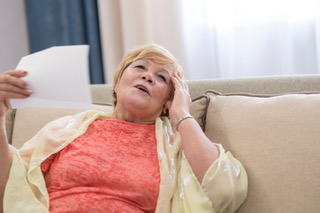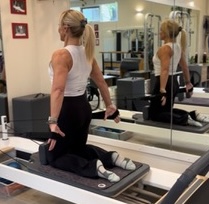
Article written by: Katherine Tsebelis
Are your 35+ year old female clients often complaining of aches and pains?
Have they presented with shoulder and hip pain?
Do their feet hurt?
And do they always feel tired and lethargic? Anxious or depressed?
Perhaps these women are dropping out of classes or leaving your studio as they feel they’re no longer achieving results like they used to…
What’s the likely cause?
Menopause… or to be more specific, perimenopause!
This is the period in which women can struggle the most, in almost every aspect of their lives. Many women leave the workplace, experience mental illness and abandon their exercise and wellbeing routines.
This is where your role as their instructor is crucial. Why? Because as their instructor, you are most likely the person in the health and wellness space they have the most contact with and the relationships formed in our studios and practices are built on connection and trust. By understanding the changes women go through in perimenopause and menopause, you can help support them in navigating this transitory yet potentially challenging period of their lives.
Women are notorious for neglecting their self-care at the best of times, often prioritising the needs of others before their own: children, spouses, career and the demands of a busy household generally take priority. With what limited time and capacity they may have left, it’s common for the average middle-aged female to de-prioritise their needs. Their class attendance becomes erratic, they cancel a few classes, and eventually terminate their membership.
We’ve all heard of menopause, but we need to focus more on perimenopause, the period that precedes it. In fact, the definition of menopause is just one day on the calendar: 365 days since the last period. Beyond this day is coined post menopause.
Perimenopause is associated with many symptoms (over 30!!!), including the well-known vasomotor types (hot flushes and night sweats), but not as well recognized are symptoms such as brain fog, exhaustion, anxiety, depression, heart disease, cognitive decline and brittle bones, to name a few!
This hormonal phase can last up to 10 years, with an average of 7 years. Menopause can occur anywhere between 45 and 55, with the average age being 51. Unbelievably, perimenopause can begin as early as 35 years of age! Historically, the poster woman for menopause has been a greying, flustered lady with wrinkles furiously fanning herself. A female in their mid-to-late 30s who is in the throes of her career, relationship, and may be contemplating fertility or has young children, is hardly the image that comes to mind.
What Causes The Symptoms Of Perimenopause?
Fluctuating and gradually declining hormones, particularly Oestrogen, Progesterone and Testosterone. Almost every organ and tissue has hormone receptors, so many symptoms occur as the cells are unable to perform their function adequately, secondary to the reduction of available hormones. From the nervous, cardiovascular and musculoskeletal systems to our skin, pelvic floor and microbiome!
The Importance of Hormones on Our Organs
The impact hormones have on all our systems is significant and far-reaching. In fact, the top 10 causes of death in women are linked to hormonal imbalances affecting:
- Heart disease
- Stroke
- Alzheimer’s disease
- Type 2 Diabetes Mellitus
During this time, common musculoskeletal problems can arise, including:
- Shoulder – frozen/painful, rotator cuff disorder
- Hip/glute tendinopathies
- Feet – Plantar fasciopathy, Achilles tendinopathy, pain
- Hands – joint/muscle pain, Carpal tunnel syndrome
- Osteopenia/Osteoporosis
The enormity of the impact of fluctuating and declining hormones have on females transitioning through perimenopause and menopause cannot be underestimated, as our middle-aged clients may experience significant changes in energy, strength, mood and recovery. As Pilates instructors, we can play an instrumental role in supporting women to manage these changes. Our sessions should focus on balance, strength and mobility, accompanied by breathwork to help reduce stress and improve nervous system regulation. Resistance and weight-bearing work are integral in maintaining bone and muscle health and the encouragement of mindful movement can enhance mood and cognitive focus.
When planning your Pilates programs, it is of paramount importance to consider the many factors that play a role in the functioning of our peri and post-menopausal women.

Strategies in Pilates sessions:
- Regular & structured format
- High impact exercises, e.g. jumps (mat or jump board)
- Balance/proprioception work
- Mobility/flexibility training
- Pacing of exercise
- Cooling strategies
- Focus on breathwork
Treatment strategies:
- Shoulder – shoulder stabilisation and Range of Movement (ROM) exercises as able
- Hip/Glute – hip control and ROM exercises
- Feet – mobility of foot joints, control of intrinsic muscles
- Hands – stretches and strength of all muscle groups, weight-bearing exercises
- Osteopenia/Osteoporosis – jumps (or modifications), weight-bearing exercises, spinal stabilisation and hip muscle control
We can have an immensely positive impact on our clients’ perimenopause and menopause experience and through the lens of perimenopause awareness, continue to grow with our clients. As Pilates instructors, we have valuable knowledge and skills that support women through the most important aspects of life: pre- and post-pregnancy, perimenopause and post menopause, prevention of and recovery from injury as well as overall health and well-being.
Kath Tsebelis
2025 PAA Conference presenter, perimenopause physiotherapist, certified menopause coach, Clinical Pilates instructor.

Comments are closed.